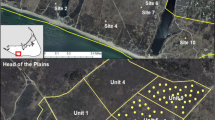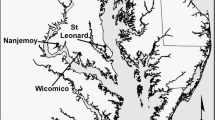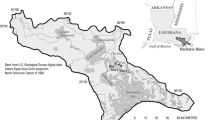Abstract
Extreme climatic events disturb plant communities, altering species composition, and abundance. For herbaceous populations on coastal beaches, responses to disturbance are often spatially heterogeneous and depend on species’ life history. This study documents the effects of two overwash events, caused by Hurricane Irene in August 2011 and Superstorm Sandy in October 2012, on the abundance of native species on a low-lying, unprotected beach on Staten Island, New York, USA. Temporary plots (33 cm diameter) spaced at 3-m intervals along 30-m transects perpendicular to shoreline, were used in September 2007, 2011, 2012, and 2013 to survey lower (0–9 m), middle (12–21 m), and upper (24–30 m) regions of the same beach. The same procedure was used to quantify seedling recruitment in spring (May) after each overwash. Complex changes in density the year after each overwash were specific for distinct beach regions and depended on species’ life history. Rhizomatous perennial grasses (Ammophila breviligulata and Panicum amarum) maintained or increased ramet populations, possibly stimulated by sand deposition on the middle and upper beach. The first overwash was early enough in the growing season to permit subsequent seed production during autumn, and seedling recruitment occurred for three native annuals (Cenchrus tribuloides, Heterotheca subaxillaris, and Triplasis purpurea), and the tall perennial Solidago sempervirens the next spring. The second overwash was later in autumn and probably removed seeds from the site and/or deeply buried the seeds of two annuals (Cenchrus and Heterotheca) which did not recruit seedlings the next spring. Triplasis seedlings were abundant in a blowout on the lower beach. Given more frequent storms and sea-level rise in the future, it becomes imperative to maintain an assemblage of native plant species with diverse life histories when restoring coastal beaches.






Similar content being viewed by others
References
Aerts JCJH, Lin N, Wouter Botzen WJ, Emanuel K, de Moel H (2013) Low-probability flood risk modeling for New York City. Risk Anal 33:772–788
Awang MB, Monaco TJ (1978) Germination, growth, development, and control of camphorweed (Heterotheca subaxillaris). Weed Sci 26:51–57
Benimoff AI, Fritz WJ, Kress M (2015) Superstorm Sandy and Staten Island: learning from the past, preparing for the future. In: Bennington JB, Farmer EC (eds) Learning from the impacts of Superstorm Sandy. Elsevier, Amsterdam, pp 21–40
Bitton MCA, Hesp PA (2013) Vegetation dynamics on eroding to accreting beach-foredune systems, Florida panhandle. Earth Surf Process Landforms 38:1472–1480
Boyce SG (1954) The salt spray community. Ecol Mono 24:29–67
Cartica RJ, Quinn JA (1982) Resource allocation and fecundity of populations of Solidago sempervirens along a coastal dune gradient. Bull Torrey Bot Club 109:299–305
Cheplick GP (2005) Patterns in the distribution of American beachgrass (Ammophila breviligulata) and the density and reproduction of annual plants on a coastal beach. Plant Ecol 180:59–69
Cheplick GP (2006) Seed rain, transient seed banks, and seed recruitment of annuals on a coastal beach. J Torrey Bot Soc 133:379–392
Cheplick GP (2016) Changes in plant abundance on a coastal beach following two major storm surges. J Torrey Bot Soc 143:180–191
Cheplick GP, Aliotta M (2009) The abundance and size of annuals in a coastal beach community is related to their distance from seaside goldenrod (Solidago sempervirens). J Torrey Bot Soc 136:102–109
Cheplick GP, Demetri H (2000) Population biology of the annual grass Triplasis purpurea in relation to distance from shore on Staten Island, New York. J Coast Conserv 5:145–154
Cheplick GP, Grandstaff K (1997) Effects of sand burial on purple sandgrass (Triplasis purpurea): the significance of seed heteromorphism. Plant Ecol 133:79–89
Courtemanche RP Jr, Hester MW, Mendelssohn IA (1999) Recovery of a Louisiana barrier island marsh community following extensive hurricane-induced overwash. J Coast Res 15:872–883
Crawford RMM (1989) Studies in plant survival: ecological case histories of plant adaptation to adversity. Blackwell Scientific, Oxford
Crawley MJ (2004) Timing of disturbance and coexistence in a species-rich ruderal plant community. Ecology 85:3277–3288
Cutter SL (2014) What makes events extreme? J Extreme Events. doi:10.1142/S2345737614020011
Dech JP, Maun MA (2005) Zonation of vegetation along a burial gradient on the leeward slopes of Lake Huron sand dunes. Can J Bot 83:227–236
Elzinga CL, Salzer DW, Willoughby JW, Gibbs JP (2001) Monitoring plant and animal populations. Blackwell Science, Malden
Fahrig L, Hayden B, Dolan R (1993) Distribution of barrier island plants in relation to overwash disturbance: a test of life history theory. J Coast Res 9:403–412
French K, Mason TJ, Sullivan N (2011) Recruitment limitation of native species in invaded coastal dune communities. Plant Ecol 212:601–609
García-Mora MR, Gallego Fernández JB, García-Novo F (1999) Plant functional types in coastal foredunes in relation to environmental stress and disturbance. J Veg Sci 10:27–34
García-Novo F, Díaz Barradas MC, Zunzunegui M, García-Mora R, Gallego Fernández JB (2004) Plant functional types in coastal dune habitats. In: Martínez ML, Psuty NP (eds) Coastal dunes: ecology and conservation. Springer, Berlin, pp 155–169
Gornish ES, Miller TE (2013) Using long-term census data to inform restoration methods for coastal dune vegetation. Estuar Coasts 36:1014–1023
Griffith AB, Ahmed T, Hildner ALG, Kuckreja S, Long S (2015) Constraints on coastal dune invasion for a notorious plant invader. AoB Plants. doi:10.1093/aobpla/plv126
Gutschick VP, BassiriRad H (2003) Extreme events as shaping physiology, ecology and evolution of plants: toward a unified definition and evaluation of their consequences. New Phytol 160:21–42
Hesp PA (1991) Ecological processes and plant adaptations on coastal dunes. J Arid Environ 21:165–191
Hesp PA, Martínez ML (2007) Disturbance processes and dynamics in coastal dunes. In: Johnson EA, Miyanishi K (eds) Plant disturbance ecology: the process and response. Academic Press, Burlington, pp 215–247
Horton RM, Liu J (2014) Beyond hurricane Sandy: what might the future hold for tropical cyclones in the North Atlantic? J Extreme Events. doi:10.1142/S2345737614500079
Jauni M, Gripenberg S, Ramula S (2015) Non-native plant species benefit from disturbance: a meta- analysis. Oikos 124:122–129
Jentsch A, Kreyling J, Beierkuhnlein C (2007) A new generation of climate-change experiments: events, not trends. Front Ecol Environ 5:365–374
Kelly JF (2014) Effects of human activities (raking, scraping, off-road vehicles) and natural resource protections on the spatial distribution of beach vegetation and related shoreline features in New Jersey. J Coast Conserv 18:383–398
Lonard RI, Judd FW (2011) The biological flora of coastal dunes and wetlands: Panicum amarum S. Elliott and Panicum amarum S. Elliott var. amarulum (AS Hitchcock and MA Chase) P.Palmer. J Coast Res 27:233–242
Lonard RI, Judd FW, Stalter R (2011) Biological flora of coastal dunes and wetlands: Heterotheca subaxillaris (J. de Lamarck) N. Britton & H. Rusby. J Coast Res 27:1052–1058
Lonard RI, Judd FW, Stalter R (2015) The biological flora of coastal dunes and wetlands: Solidago sempervirens L. and Solidago sempervirens L. subsp. mexicana (L.) Semple. J Coast Res 31:1512–1520
Maun MA (1984) Colonizing ability of Ammophila breviligulata through vegetative regeneration. J Ecol 72:565–574
Maun MA (2004) Burial of plants as a selective force in sand dunes. In: Martínez ML, Psuty NP (eds) Coastal dunes: ecology and conservation. Springer, Berlin, pp 119–135
Maun MA (2009) The biology of coastal sand dunes. Oxford University Press, New York
Maun MA, Baye PR (1989) The ecology of Ammophila breviligulata Fern. on coastal dune systems. CRC Crit Rev Aquat Sci 1:661–681
Maun MA, Lapierre J (1984) The effects of burial by sand on Ammophila breviligulata. J Ecol 72:827–839
Maun MA, Perumal J (1999) Zonation of vegetation on lacustrine coastal dunes: effects of burial by sand. Ecol Lett 2:14–18
Miller TE (2015) Effects of disturbance on vegetation by sand accretion and erosion across coastal dune habitats on a barrier island. AoB Plants. doi:10.1093/aobpla/plv003
Miller DL, Thetford M, Yager L (2001) Evaluation of sand fence and vegetation for dune building following overwash by Hurricane Opal on Santa Rosa Island, Florida. J Coast Res 17:936–948
Miller DL, Thetford M, Schneider M (2008) Distance from the Gulf influences survival and growth of three barrier island dune plants. J Coast Res 24:261–266
Miller TE, Gornish ES, Buckley HL (2010) Climate and coastal dune vegetation: disturbance, recovery, and succession. Plant Ecol 206:97–104
Miller KG, Kopp RE, Horton BP, Browning JV, Kemp AC (2013) A geological perspective on sea level rise and its impacts along the U.S. mid-Atlantic coast. Earth’s Future 1:3–18
Murdukhayeva A, August P, Bradley M, LaBash C, Shaw N (2013) Assessment of inundation risk from sea level rise and storm surge in northeastern coastal national parks. J Coast Res 29:1–16
Niu S, Luo Y, Li D, Cao S, Xia J, Li J, Smith MD (2014) Plant growth and mortality under climatic extremes: an overview. Environ Exp Bot 98:13–19
Nylén T, le Roux PC, Luoto M (2013) Biotic interactions drive species occurrence and richness in dynamic beach environments. Plant Ecol 214:1455–1466
Orsenigo S, Mondoni A, Rossi G, Abeli T (2014) Some like it how and some like it cold, but not too much: plant responses to climate extremes. Plant Ecol 215:677–688
Parker VT, Simpson RL, Leck MA (2008) The seedling in an ecological and evolutionary context. In: Leck MA, Parker VT, Simpson RL (eds) Seedling ecology and evolution. Cambridge University Press, Cambridge, pp 373–389
Smith MD (2011) An ecological perspective on extreme climatic events: a synthetic definition and framework to guide future research. J Ecol 99:656–663
Snyder RA, Boss CL (2002) Recovery and stability in barrier island plant communities. J Coast Res 18:530–536
Wang P, Horwitz MH (2007) Erosional and depositional characteristics of overwash deposits caused by multiple hurricanes. Sedimentology 54:545–564
Wilson JB, Sykes MT (1999) Is zonation on coastal sand dunes determined primarily by sand burial or by salt spray? A test in New Zealand dunes. Ecol Lett 2:233–236
Acknowledgments
For assistance with field surveys, I thank Amelia Harrichandra, Kinnea Keating, Lisa LaManna, Anna Liu, and students in the autumn Ecology class at the college. The Natural Resource Management Division of the National Park Service, U.S. Department of the Interior, generously provided a Research and Collecting Permit to work at Miller Field Beach. George W. Frame, Gateway National Recreation Area, provided useful information on the species at Miller Field Beach. The manuscript benefited greatly from the comments and suggestions of two anonymous reviewers.
Funding
Funding was provided by Grant 65173-0043 from the Professional Staff Congress, City University of New York, Research Award Program.
Author information
Authors and Affiliations
Corresponding author
Additional information
Communicated by Anna R. Armitage.
Rights and permissions
About this article
Cite this article
Cheplick, G.P. Responses of native plant populations on an unprotected beach to disturbance by storm-induced overwash events. Plant Ecol 218, 105–118 (2017). https://doi.org/10.1007/s11258-016-0670-1
Received:
Accepted:
Published:
Issue Date:
DOI: https://doi.org/10.1007/s11258-016-0670-1




